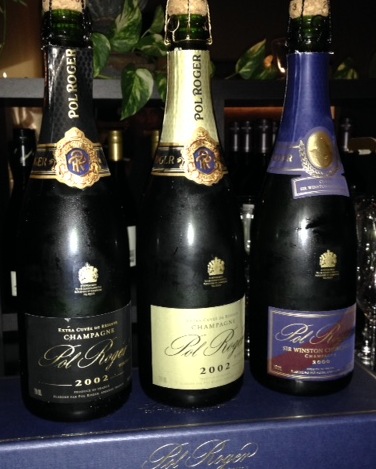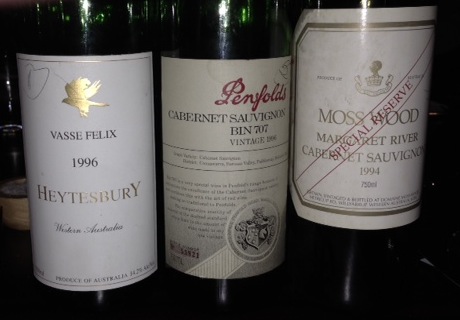Vintage in Focus by Barry Weinman
I am in the fortunate position to be able to drink old wines regularly. Often, this is in the setting of dinner with friends, or a themed tasting. It is a rare treat however, to be able to drink a number of aged wines from the same vintage.
To make this tasting even more interesting, all wines were Bordeaux varietals or blends and the wines were equally divided between France and Australia. An added bonus was that 1996 was an excellent year on both sides of the globe. I could not find a bottle of Mosswood from this vintage, so substituted a bottle of the 1994 Reserve.
All wines came from the Wine and Food Society of Western Australia’s cellar. The Australian wines had been in the cellar since launch, whereas many of the French wines I purchased a few years ago when they had been shipped ex-cellar.
Opening the wines told a tale of two standards. The corks in the French wines were uniformly in great condition. Longer than the Australian’s, but also of perceptibly higher quality. The Australian wines’ corks started crumbling with a standard corkscrew, whereas the French wines’ corks came out easily without breaking.
Once again, I was very grateful to have a Durant corkscrew on hand to assist with cork removal. This remarkable device is a must for those regularly opening wines older than 15 years. Remarkably, there was no discernible cork taint in any of the wines. This was indeed a very special day!
Initially, I planned on serving the wines in matched pairs (Australia v France). On opening the wines, this plan changed as the overt power of the Australian wines would have overwhelmed the French wines.
The Wines
Perhaps the biggest surprise on the night was the Champagnes in Bracket One. Support for the three wines was equally divided across the group. The “standard” 2002 was the most accessible, making it the choice for those who value drinkability.
At the other end of the spectrum, the Sir Winston Churchill is a sublime wine that was the pick for the aficionados among us. Sitting in the middle and offering outstanding value was the Blanc de Blanc. A great drink!
The highlight of Bracket Two was the Roc de Cambes, coming from a fully mature vineyard that has similarities to St Emillon. This demonstrated just how good the wines from Cotes de Bourg (Cotes de Bordeaux) can be.
Bracket Three saw a step up in perceived quality, as all wines were of Grand Cru status. This was also reflected in the overall quality. The highlight was the Cantemerle, a still youthful wine of real class.
Bracket Four saw the first of the Australian wines. The change in style was immediately apparent, with the fruit more accessible. The wines retained balance and poise, but there was a degree of immediacy that, if anything, made the wines more accessible to the average drinker.
The Wynns displayed classic Coonawarra fruit and was a delight to drink. The Plantagenet was my pick. A wine that is in its prime, but one that will also last for years.
 The final bracket consisted of three superstars. The Mosswood was the most complete drink, the 707 the most long-lived. All were brilliant wines in their own right, and equal to the best Cabernets anywhere in the world, albeit in a different style to the French. Ultimately, it was the Vasse Felix Heytesbury that was my pick for the night!
The final bracket consisted of three superstars. The Mosswood was the most complete drink, the 707 the most long-lived. All were brilliant wines in their own right, and equal to the best Cabernets anywhere in the world, albeit in a different style to the French. Ultimately, it was the Vasse Felix Heytesbury that was my pick for the night!
Bracket One
Pol Roger – Champagne – 2002. A rich and developed Champagne that is powerful and complex, with honeyed, aged notes. Textured and very long, this was preferred by several guests.
Pol Roger – Champagne – Blanc de Blanc – 2002. Perfumed and floral, the taut chardonnay fruit characters are clearly expressed here. Refined and delicate, yet there is latent power and excellent length. A great wine that will age well for another few years at least.
Pol Roger – Champagne – Sir Winston Churchill – 2000. The term “Less is more” comes to mind here. Very fine and delicate, yet has tremendous presence in the mouth. Elegance is the key.
Bracket Two
Lilian Ladouys – Saint Estephe – 1996. Lovely fragrant nose, with subtle spice complementing the still-fresh fruit. The palate is fully mature, with decent depth and length and a well-structured finish. Good drinking.
Roc de Cambes – Cotes de Bourg – 1996. Made primarily from Merlot, the fantastic fruit here has an almost new-world richness. Cassis and spice on the nose. The silky mouthfeel and depth of fruit on the palate are noteworthy. Considered by many to be the best wine from the Cotes de Bourg, this was a standout.
Labegorce – Margeaux – 1996. The perfumed fruit is typical of Margeaux, but the palate was starting to dry out. Perhaps not the best bottle.
Bracket Three
Clos de L’Oratoire – St. Emillon – Grand Cru – 1996. Delicious sweet fruit that has obvious power. Very long and texture, this is drinking perfectly now.
Chateau Cantemerle – Haut Medoc – 5th Growth – 1996. Sweet ripe fruit, with minty highlights. A powerful wine, with still firm tannins. The excellent length on the finish is a feature. A stand-out.
Grand Puy Ducasse – Pauliac – 5th Growth – 1996. Obvious powerful fruit, with a touch of earthy/ funky notes adding to the appeal. Fine tannins fan out on a long finish.
Bracket Four
Wynns – Cabernet Sauvignon – “Black Label” – 1996. Cassis and menthol speaks of classic Coonawarra Cabernet. The palate is not overly dense, but this is a delightful drink.
Plantagenet – Cabernet Sauvignon – 1996. Plump, fresh fruit on the nose. The palate is bright, fresh, taut and full of life. The balance is a highlight and the finish is long and fine. Excellent now, but will hold.
Irvine – Grand Merlot – 1996. A big wine, full of plump ripe fruit. Loved by some, but this was a bit overdone for me. This was, perhaps not a typical bottle, as I have enjoyed excellent bottles of this vintage in the recent past.
Bracket Five
Vase Felix – Cabernet Sauvignon – Heytesbury – 1996. Intense, powerful fruit, with leather and spice over the superb fruit. The palate is remarkably youthful, with red fruit characters. A complete wine and quite spectacular!
Mosswood – Cabernet Sauvignon – Reserve – 1994. The most complete wine now, and an absolute pleasure to drink. The perfumed fruit retains power, but the palate is long, refined elegant and silky. A textural treat.
Penfolds – Cabernet Sauvignon – 707 – 1996. Tight and incredibly youthful, with powerful, yet restrained fruit. The palate is closed and tight, with chewy tannins that are remarkably fine. The line and length is a feature. The intense fruit builds and builds. The proverbial iron fist in a velvet glove, a great wine!


